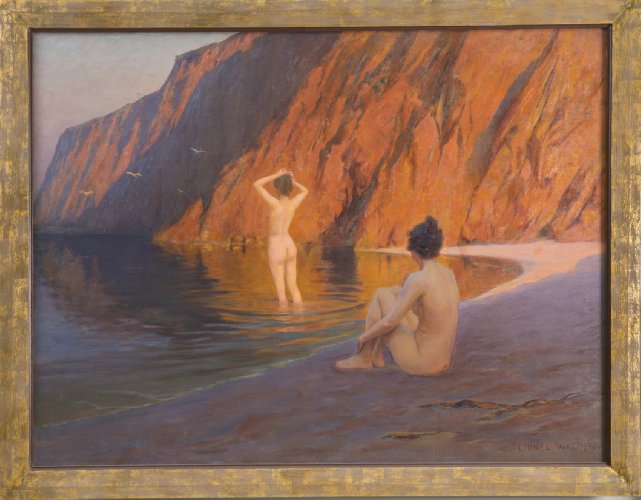Description:
Lionel Walden (1861-1933) was an American painter born in Connecticut. Since his student days, when he studied in the studio of Carolus-Duran, he has remained loyal to Paris. He lived there until 1914, regularly exhibiting his paintings at the Salon Société des Artistes Français. In 1910 he was made a knight of the French Legion of Honor. He traveled around France, Cornwall, Wales and could be seen during outdoor work on the coasts of Normandy and Brittany. He painted marine, port and railway landscapes. He was most famous for his artistic work on the Hawaiian Islands, which began in 1911, depicting views of volcanoes, genre scenes with native peoples and the surrounding landscapes.
Description of the painting:
The work depicts two nude women on the beach in a rocky coastline. The viewer takes on the role of a silent observer who appears behind them and at the same time participates in the contemplation of nature. The sloping line running from left to right across the canvas sets the boundary of the shore, separating the figures from each other. The first of them sits on the sand, her body turned three-quarters to the left. Sitting, she embraces her legs bent at the knees. Her light complexion contrasts with lush, dark hair tied high into a bun. This model had already appeared in the artist’s earlier work entitled “Bathing” from around 1895. We recognize it by the almost identical framing and realistic portrayal. The colors have changed, dictated not only by the lighting of the place where she found herself. In the first version, clear influences of impressionism are noticeable, distinguished by the play of light or a clear light-shadow contrast. Its second version is characterized by a flat color patch, which is typical of synthetism.
On the left of the main figure, we can see another one in the center of the composition. Standing in knee–high water she pins up her hair, raising her hands up. Each of the women represents a different position: a closed one – belonging to the safe space of the beach and an open one, which, in connection with the surrounding element, may symbolize the purification of body and spirit. Interpreting the work in this way, the representation of the model closer to the viewer would be a reference to passivity and reluctance to change, which is additionally emphasized by the surrounding shadow.


